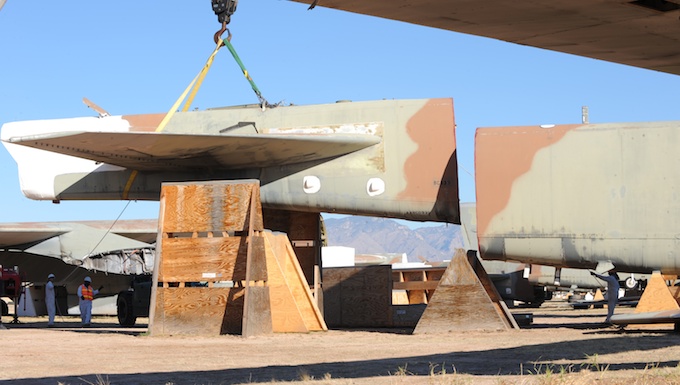A Minuteman III missile: the tip of the nuclear spear.
The U.S. spent two generations building a nuclear triad of bombers, land-based ICBMs and missile-firing submarines to prevail in the Cold War against the Soviet Union. A generation ago, the Soviet Union went away, and we continued maintaining the triad on some kind of Strangelovian autopilot.
Now those aging weapons need to be replaced, and the Congressional Budget Office has just told us how much it’s going to cost to keep the older ones afloat while developing their replacements: $355 billion between now and 2023 (not including $74 billion getting rid of old weapons and $105 billion for missile defenses to protect against enemy missiles).
That’s a cool half-trillion dollars over the coming decade for weapons most of the world hopes are never used. It, too, is happening on autopilot. The public pays little attention to the mammoth investment it represents, and the continuing hazards of having the nation’s nuclear weapons on hair-trigger alert more than 20 years after the foe they were aimed at went away.
That $355 billion to support the nation’s nuclear forces works out to $35.5 billion annually, nearly $100 million a day, $4 million an hour, $1,000 a second as far as the eye can see. And that’s only the down payment. “Annual costs are likely to continue to grow after 2023,” the CBO reports, “as production begins on replacement systems.”
Does renovating the nuclear triad make sense in a world without a nuclear-armed superpower rival, where the wonders of mutually-assured destruction can work their magic?
(MORE: Is it Time to Cut Off One Leg of the Pentagon’s Nuclear Triad?)
“I’m a believer in the triad,” General Mark Welsh, who as the Air Force chief of staff oversees two of it three legs, said last month. “I think the three legs of the triad really do give us flexibility, responsiveness and survivability in a way that you might not get with any one or two legs.”
But others think the money could be better spent elsewhere, even if it stays inside the Pentagon’s purse. “The dilemma for the military is that while spending on nuclear weapons is slated to skyrocket, the military budget has come down and will be lucky to keep pace with inflation for the remainder of the decade,” says Kingston Reif, director of Nuclear Non-Proliferation at the independent Center for Arms Control and Non-Proliferation. “The current U.S. arsenal of approximately 5,000 nuclear weapons is a Cold War holdover that is increasingly irrelevant to today’s security threats, costs billions of dollars to maintain, and sucks funding from higher priority programs.”
Politically, there is no stomach to take on the nuclear theologians who insist too much is at risk to scale back the triad. The same elected officials who refuse to pass annual appropriation bills, decline to grapple with entitlements like Social Security, and kick required budgetary reforms down the road for their kids to handle, squirm when the topic is discussed. Far easier, they have concluded, for the leaders simply to salute their followers.
The whole “nuclear enterprise” — a phrase that surfaced in the Pentagon when it became clear that the Cold War atomic aura had tarnished and needed to be replated, lest it fade into history — seems adrift. Most acknowledge its shrinking deterrent value. The threat no longer is a foe with a thousand nuclear warheads, but an enemy with one, where deterrence most likely would fail to deter. Even those in charge of the weapons can sense it, according to reporting over the past year by Robert Burns of the Associated Press, who has revealed one missile officer’s report of “rot” afflicting ICBM crews and an independent assessment of “burnout” among them.
Earlier this month, the Air Force released an inspector general’s report into the conduct of the two-star general in charge of the nation’s ICBM force during an official trip to Moscow last summer. He dismayed some of his fellow Americans when he “talked loudly about the importance of his position as commander of the only operational nuclear force in the world and that he saves the world from war every day … he also started telling the story about how he has the worst morale of any airmen in the Air Force.”
(MORE: Owner’s Guide: How to Use Your Nuclear Weapons)
Money may be needed to refurbish the nuclear enterprise, but a real-world mission is even more vital to bolster the morale of those entrusted with its care.
Perhaps the airmen are simply channeling what happened in the Arizona desert shortly before Christmas. Air Force personnel at Davis-Monthan Air Force Base attacked a B-52 Stratofortress with a circular saw. After 45 minutes, they had sliced off its tail.
“This is a bittersweet moment in my life,” retired Air Force general Earl O’Loughlin, a one-time B-52 pilot, said at the Dec. 19 event, according to an Air Force account. “To be able to come out here and watch you cut the tail off of it.”
A crane slowly lowered the tail into a custom-made cradle, 30 degrees off center and six feet (2m) from the rest of the bomber. The goal: to prove to Russian satellites overhead that the B-52G — the last of 39 to be so butchered under the New START Treaty with Moscow — is now worthless.


